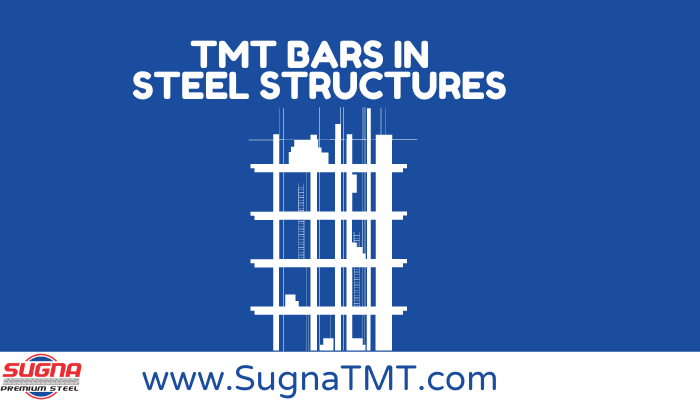Prefabricated steel structures are revolutionizing the construction industry by offering faster, more efficient, and cost-effective building solutions. As these structures gain popularity, the role of Thermo-Mechanically Treated (TMT) bars has become increasingly significant in enhancing their strength, durability, and versatility. TMT bars, known for their superior tensile strength and ductility, are now being creatively integrated into prefabricated steel structures in various innovative ways. This blog explores some of these cutting-edge uses of TMT bars in modern prefabricated construction.

1. Reinforcing Structural Components
One of the primary uses of TMT bars in prefabricated steel structures is reinforcing key structural components, such as beams, columns, and slabs. In traditional construction, TMT bars are embedded in concrete to provide tensile strength and resist loads. In prefabricated steel structures, these bars are used to reinforce steel frames, enhancing their load-bearing capacity and ensuring structural integrity.
For instance, TMT bars can be welded or bolted to steel beams and columns to create composite elements that combine the strength of both materials. This hybrid approach not only increases the overall strength of the structure but also allows for more slender and lightweight designs, reducing material usage and construction costs.
2. Enhancing Earthquake Resistance
In regions prone to seismic activity, the integration of TMT bars in prefabricated steel structures significantly enhances earthquake resistance. The high ductility of TMT bars allows them to absorb and dissipate seismic energy, reducing the risk of structural failure during an earthquake. When used in conjunction with steel frames, TMT bars help create flexible yet robust structures that can withstand lateral forces without compromising stability.
Innovative designs often involve using TMT bars to reinforce joints and connections between prefabricated steel components, ensuring that the entire structure moves as a unified whole during seismic events. This method minimizes the chances of structural damage and provides an added layer of safety for occupants.
3. Precast Concrete Panels Reinforced with TMT Bars
Another innovative use of TMT bars is in the creation of precast concrete panels used in prefabricated steel structures. These panels, which form the walls, floors, and ceilings of a building, are cast off-site and then transported to the construction site for assembly. By reinforcing these panels with TMT bars, manufacturers can produce stronger, more durable components that contribute to the overall stability of the structure.
TMT-reinforced precast panels are particularly beneficial in multi-story buildings, where they help distribute loads evenly across the structure and provide additional resistance against lateral forces such as wind and earthquakes. The use of these panels also speeds up construction times, as they can be quickly and easily installed on-site.
4. Supporting Large Spans and Cantilevers
Prefabricated steel structures often feature large spans and cantilevers, which require additional support to prevent sagging or collapse. TMT bars are used innovatively in these situations to provide the necessary reinforcement. For example, TMT bars can be integrated into steel trusses or girders, enhancing their ability to support large spans without the need for additional columns or supports.
This application is particularly useful in industrial buildings, warehouses, and sports facilities, where open spaces and unobstructed floor plans are essential. The use of TMT bars in these structures ensures that they remain stable and secure, even under heavy loads.
5. Modular Construction with Reinforced Connections
Modular construction, a subset of prefabrication, involves assembling individual modules or units to create a complete building. In such projects, the connections between modules are critical to the overall strength and stability of the structure. TMT bars play a crucial role in reinforcing these connections, ensuring that the modules are securely joined and can withstand the stresses of transportation, assembly, and use.
Innovative designs often incorporate TMT bars into the joints and seams between modules, providing additional tensile strength and preventing separation or misalignment. This approach not only enhances the structural integrity of modular buildings but also allows for greater flexibility in design, enabling the creation of complex and dynamic architectural forms.
6. Integration in Lightweight Composite Decking
In modern prefabricated steel structures, lightweight composite decking systems are becoming increasingly popular due to their ability to reduce overall building weight while maintaining structural strength. TMT bars are innovatively used in these systems to reinforce the composite materials, such as steel and concrete, ensuring that the decking can support heavy loads and resist deformation.
By integrating TMT bars into composite decking, architects and engineers can create thinner, lighter floor and roof systems that do not compromise on performance. This not only reduces material costs but also speeds up construction times, making it easier to meet tight project deadlines.
7. Incorporating TMT Bars in Architectural Features
Beyond their structural applications, TMT bars are also being used creatively in the architectural features of prefabricated steel structures. For example, TMT bars can be bent and shaped to create decorative elements, such as screens, railings, and facades. These features add aesthetic value to the building while also providing additional reinforcement and security.
In some cases, TMT bars are used to create intricate lattice patterns or support green walls, blending functionality with design. This innovative use of TMT bars highlights their versatility and potential to contribute to both the structural and visual aspects of modern architecture.
Conclusion
The innovative uses of TMT bars in prefabricated steel structures demonstrate the material’s versatility and importance in modern construction. By reinforcing structural components, enhancing earthquake resistance, supporting large spans, and contributing to modular construction, TMT bars play a crucial role in ensuring the strength, durability, and adaptability of prefabricated buildings.
As the construction industry continues to evolve, the integration of TMT bars in prefabricated steel structures will likely expand, offering new possibilities for architects and engineers to create safe, sustainable, and aesthetically pleasing buildings. Whether for residential, commercial, or industrial applications, the innovative use of TMT bars is paving the way for the future of construction.

